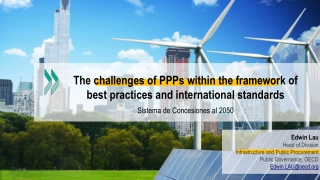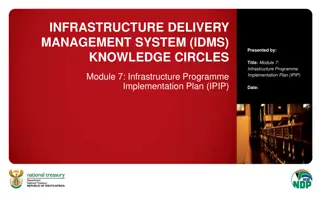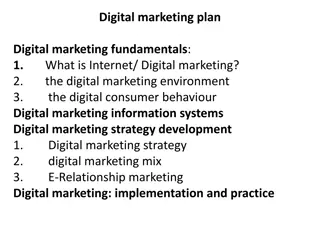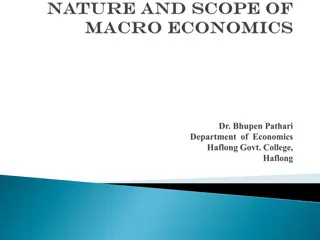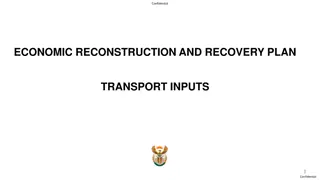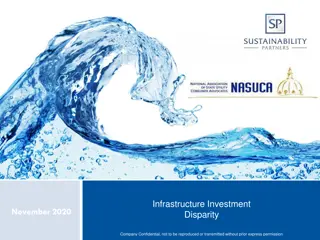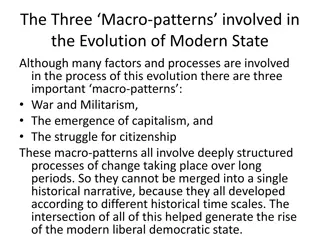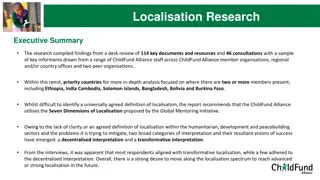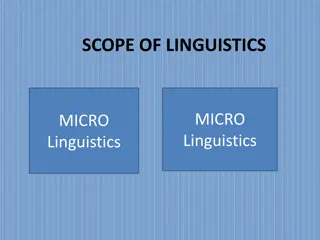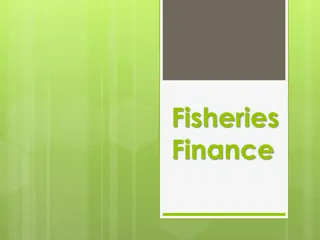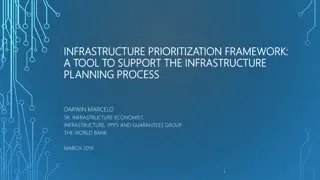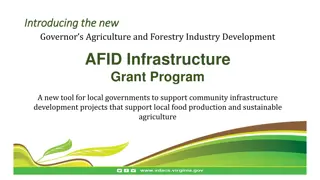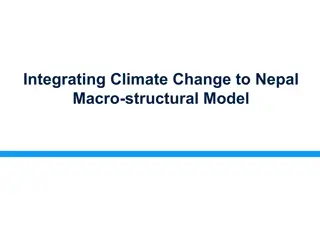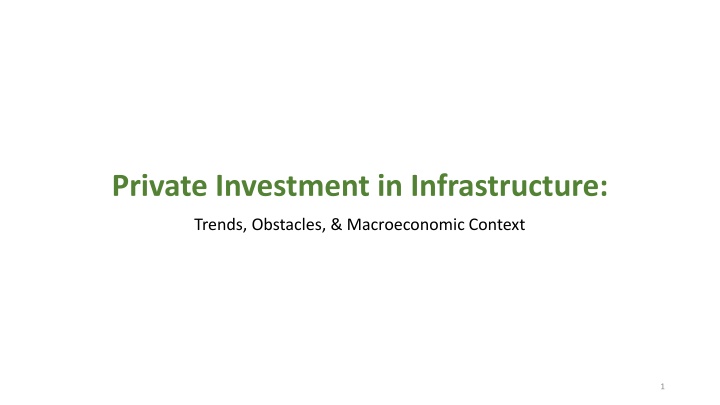
Challenges and Trends in Private Infrastructure Investment
Explore the latest trends, challenges, and the macroeconomic context of private investment in infrastructure, highlighting the skew towards high-income countries, stagnant primary market investments, declining enthusiasm in PPPs, and low mobilization for social and adaptation projects. Discover insights on how secondary markets impact primary market investments.
Download Presentation

Please find below an Image/Link to download the presentation.
The content on the website is provided AS IS for your information and personal use only. It may not be sold, licensed, or shared on other websites without obtaining consent from the author. If you encounter any issues during the download, it is possible that the publisher has removed the file from their server.
You are allowed to download the files provided on this website for personal or commercial use, subject to the condition that they are used lawfully. All files are the property of their respective owners.
The content on the website is provided AS IS for your information and personal use only. It may not be sold, licensed, or shared on other websites without obtaining consent from the author.
E N D
Presentation Transcript
Private Investment in Infrastructure: Trends, Obstacles, & Macroeconomic Context 1
(I) Private Infrastructure Investment Trends Sources: Global Infrastructure Hub, Eurodad, OECD. 2
Private investment in infrastructure skews toward HICs and has declined everywhere else Global Infrastructure Hub (GIH), 2022. While green bond financing has been gathering pace since 2015, the green loan market is much more nascent and has only been noticeably active since 2020, almost exclusively in high-income markets. 3
Private investment in infrastructure has been stagnant for over six years GIH, 2022. Private investment in infrastructure projects in primary markets has been stagnant for eight years running and remains in the order of USD150-175 billion each year. 4
Investor enthusiasm in public-private partnerships (PPPs) is declining Eurodad, 2022. Today s analysis shows that, since 2012, the amount of money invested in PPP projects in the developing world has been volatile. The onset of the pandemic in 2020 led to a drastic decline in investments in PPP projects. 5
Private capital mobilized for social and adaptation investments is very low OECD, 2022. In 2018-20, almost two-thirds (62%) of mobilised private finance benefitted projects in sectors falling under the economic infrastructure and services, most notably banking and business services, energy and transport and storage. 6
Secondary markets for infrastructure do not seem to incentivize primary market investment in infrastructure GIH, 2022. While primary market investment has stagnated under $170bn since 2014, secondary market investment has skyrocketed to $600bn in the same period. 7
(I) Takeaways Private investor involvement is stagnating and is skewed toward richer countries Despite the hype, PPPs are not a growing asset class Private capital mobilized for social/adaptation sectors is a fraction of what s mobilized for energy, infrastructure, transport more bankable sectors Secondary markets for infrastructure financing do not necessarily juice primary markets for investment 8
(II) Infrastructure risks and returns Sources: Global Infrastructure Hub, Huber and Gormsen, EDHECinfra. 9
Unlisted infrastructure sees higher returns than listedand both are resilient to shocks relative to equity returns in other sectors GIH, 2022. The fall in returns on infrastructure equities is significantly less than the fall in listed global equities returns (-20%) which highlights the resilience and stability of infrastructure equities during economic downturns. 10
Interest rate hikes present the largest risk to infrastructure equity values GIH, 2022. GIH, 2022. The highly inflationary environment has triggered a substantial increase in the expected level of future dividends, which increased the NAV (net asset value), but also in interest rates and risk premiums, which reduced the NAV The highly inflationary environment has triggered a substantial increase in the expected level of future dividends, which increased the NAV (net asset value), but also in interest rates and risk premiums, which reduced the NAV 11
Unlike equity, infrastructure debt always has higher returns than risks GIH, 2022. In emerging markets, unlisted infrastructure equities are attractive as they provide higher returns than listed global equities at roughly the same level of risk, while in developed markets they provide higher returns than listed global equities at a lower risk. 12
Infrastructure debt is investment-grade when maturities exceed 13 years! GIH, 2022. As the default curve excludes older infrastructure loans, infrastructure debt becomes less risky and performs faster as an investment grade security. Thus, infrastructure debt performance has been continually improving over at least three decades. 13
However, a lower cost of capital doesnt necessarily incentivize investment investors have their own preferences for returns Huber and Gormsen, 2022. Hurdle rates (or discount rates) are rates of return a project must generate to ensure that an investor s earnings quality does not deteriorate. Huber and Gormsen find that discount rates are substantially higher than the perceived cost of capital, on average twice as large. 14
Where infrastructure is concerned, investors dont know much EDHECinfra, 2022. This data shows that risks are properly priced in markets, yet they are not reflected in fund hurdle rates. Indeed, with an 8% hurdle, equity investments like renewable energy projects are virtually impossible. 15
And, as a result, theyre not spending GIH, 2022. High hurdle rates of infrastructure funds constrain fund managers from investing in infrastructure assets.Trends in hurdle rates have not aligned with trends in returns over time. 16
There are other barriers to institutional investment in infrastructure: Fiduciary duty requirements Requirement to invest only in investment-grade securities Short-term bias (fund manager returns and bonuses are evaluated annually or more frequently) Preference for large-ticket transactions (above $100m) Preference for standardized transactions Liquidity preference preference for safe assets with stable value and easy redemption (usually dollar assets) Liability management strategies (for pension funds) 17
(II) Takeaways Infrastructure debt has higher returns than risks Interest rate hikes threaten infrastructure equity returns but these returns remain resilient against shocks relative to other equity asset classes Infrastructure debt held more than 13 years is usually investment-grade, reinforcing the utility of long-term debt for infrastructure development However, lowering the cost of capital might not incentivize investment, because investors don t have a good sense of infrastructure risks and returns As a result, investors are not spending money on the sector! Investors also face lots of other barriers to investing in illiquid, long-term, low-return, heterogenous infrastructure 18
(III) Headwinds Credit and Capital Sources: UN DESA, Songwe/Stern Report, World Bank, Bloomberg, IMF Global Financial Stability Report. 19
Covid-era ratings downgrades have impacted emerging markets (EMs) more than advanced economies (AEs) UN DESA, 2021. the shock delivered by COVID-19 was not evenly distributed across economies. In fact, the hit to growth and public debt accumulation has been twice as large for AEs than for EMDEs, not to mention their significantly larger death tolls. Given that context, it is not at all clear why rich countries ratings remained largely untouched even as their poorer peers were subject to more extensive downgrades. 20
Borrowing costs are increasing for EMs, restricting their ability to invest in their own development Songwe/Stern Report, 2022. credit rating agencies have been systematically lowering their assessments of sovereign creditworthiness since the onset of the pandemic. Few countries are now classified as having an investment grade rating (12 or above on the scale below). 21
All while external debt levels in LMICs have surged Financial Times/World Bank, 2023. Just between 2000 and 2021, the share of public and publicly guaranteed external debt of low and lower- middle income countries (other than that held by IFIs) owed to bondholders jumped from 10 to 50 per cent, while the share owed to China rose from 1 to 15 per cent. 22
Debt service costs are rising, constraining domestic fiscal space IMF Global Financial Stability Report, April 2023. While debt-to-GDP levels are high in both frontier and emerging markets after the pandemic compared with those over the last two decades, frontier markets have significantly less fiscal space given much higher interest-to- revenue ratios. 23
Cost of credit has exploded for importer countries with lower credit ratings (1) Financial Times/World Bank, 2023. (2) IMF Global Financial Stability Report, October 2022. highly indebted countries that have already suffered the Covid shock and a sharp deterioration in their terms of trade, as food and energy prices soared, will now be in even more serious and enduring trouble 24
Bond issuances and capital market expansion in EMs fell sharply in 2022, further reducing EMs access to financing Financial Times/World Bank, 2023. Thus, for emerging and developing countries as a whole, the bank forecasts that aggregate investment in 2024 will be 8 per cent lower than expected back in 2020. 25
Global sustainable debt issuance fell, too Bloomberg, 2022. Through November of this year [2022], sustainable debt issuance is just under $1.2 trillion. At the same time last year, companies had raised more than $1.5 trillion. 26
Dollar appreciation and Fed rate hikes have raised debt servicing costs and import prices globally Financial Times/World Bank, 2023. An obvious danger now is that of waves of defaults in over- indebted developing countries. Taken together, these shocks will cause long-lasting effects, perhaps lost decades, in many vulnerable places. 27
Global liquidity deteriorationparticularly in sovereign bondsthreatens emerging markets IMF Global Financial Stability Report, April 2023. Poor market liquidity has likely amplified recent gyrations seen in global markets. This issue is particularly evident in sovereign bond markets, likely reflecting both high levels of uncertainty and the effect of quantitative tightening in the euro area, the United States, and the United Kingdom. 28
2022 saw a flight to safety away from emerging markets and toward dollars, IMF Global Financial Stability Report, October 2022. Amid persistent inflationary pressures, major central banks are significantly normalizing their policy stance, and financial conditions have tightened since the beginning of 2022. This has coincided with large outflows from OEFs in recent months, especially from high-yield corporate bond funds and emerging market equity and bond funds. 29
But not even Treasuries are particularly safesuggesting a latent threat to the global financial system IMF Global Financial Stability Report, April 2023. Poor market liquidity has likely amplified recent gyrations seen in global markets. This issue is particularly evident in sovereign bond markets, likely reflecting both high levels of uncertainty and the effect of quantitative tightening in the euro area, the United States, and the United Kingdom. 30
Investors seem slightly more confident in EMs this year, but not by historical standards Financial Times/Brookings, 2023. Policymakers, especially central bankers, were floundering in an environment of rapidly multiplying risks. 31
And, last but not least, the prices of critical green commodities are fluctuating wildly, making investment even more challenging for investors to plan Bloomberg, 2022-23. The volatility is rippling across the solar supply chain and pressuring manufacturing giants even as they plan expansions to provide the world with more clean energy needed to stave off the impacts of climate change. 32
(III) Takeaways Credit rating agency downgrades and market turmoil have raised EM cost of capital and have degraded EM fiscal space for investment EMs are issuing less debt, including green debt, given high costs and credit spreads Key green commodity prices are fluctuating, making investment planning harder 2022 saw a flight to safety away from EMs suggesting limited investor confidence in EMs Yet shallow Treasury market depth suggests not even dollar funding markets are particularly safe 33
(IV) Financial Sector Risks Sources: IMF Global Financial Stability Report, Bloomberg. 34
A global shock would hammer global consumption and demand growth, compounding all the above issues Bloomberg, 2022. Drawing on a suite of macro models, Bloomberg Economics has estimated the aggregate impact if everything goes wrong at the same time. Unsurprisingly, the results aren t pretty. 35
Given recent events, that shock could come from the nonbank financial sector! IMF Global Financial Stability Report, April 2023. the analysis focuses on vulnerabilities related to leverage, liquidity, and interconnectedness as well as on emerging market and developing economy vulnerabilities that stem from NBFI intermediation of cross- border flows. These flows tend to be more sensitive to global financial conditions, thus contributing to the procyclicality of capital flows. 36
But theres a lot that we dont know about the risks they face IMF Global Financial Stability Report, April 2023. the analysis focuses on vulnerabilities related to leverage, liquidity, and interconnectedness as well as on emerging market and developing economy vulnerabilities that stem from NBFI intermediation of cross- border flows. These flows tend to be more sensitive to global financial conditions, thus contributing to the procyclicality of capital flows. 37
We do know that high-yield sovereign bonds, EM bonds in particular, are vulnerable to liquidity mismatches and portfolio runs IMF Global Financial Stability Report, April 2023. Liquidity mismatches make funds vulnerable to runs because investors have an incentive to redeem ahead of others which can contribute to volatility in asset markets and threaten financial stability. Over the past year, the liquidity of open-end funds holdings has deteriorated to levels last seen at the onset of the COVID-19 pandemic, implying high vulnerabilities of asset markets as a result of liquidity mismatches. 38
so, in a crunch, investors are selling less liquid EM bonds first, exacerbating the above stresses on EM fiscal space IMF Global Financial Stability Report, October 2022, April 2023. Across different types of bonds, corporate high-yield and emerging market bonds are more likely to be held by more illiquid funds and are hence highly vulnerable to fund redemptions. In addition, liquidity mismatches in emerging market and developing economy debt funds given the medium to low liquidity of most fixed-income assets in these economies may exacerbate the scale of redemptions under stress market conditions. 39
(IV) Takeaways Shocks will propagate across the global financial system and they might even originate within the financial system, if the last three years are any indicator Institutional investors have high exposure to liquidity and interconnection risk, and rising leverage in the nonbank financial sector exacerbates these problems In a crunch, EM securities will tank in value first, and worst EM fiscal space is the first casualty of a global shock absent countercyclical intervention 40
(V) Conclusion Sources: Bloomberg, Financial Times. 41
The places that need the most investment are not getting it Bloomberg, 2023. Yet investment in renewable energy in Africa fell to an 11-year low in 2021, comprising just 0.6% of the global total, according to a report by BloombergNEF. Financing options are insufficient and expensive because lenders worry about the risks of taking on new projects in often politically or economically unstable countries with broken supply chains though the opportunities can be unrivaled. 42
all while the climate disaster bills stack up Bloomberg, 2023. The annual profit margins of insurance companies are getting squeezed, even as premiums are going up for products like home insurance. Reinsurers have had it worse, according to a Moody s report published earlier this month, with its profits trailing those of insurers. That s causing reinsurers to increase their premiums, limiting the types of coverage they provide, and even exiting some markets. 43
while a global debt crisis looms Financial Times, 2023. The system we currently have for resolving the debts of poor countries is not, as people say, fit for purpose . The same is true of that for helping poor countries through adverse shocks and towards sustainable development. Change is needed urgently. Start now. 44
(VI) Sources Infrastructure Monitor 2022 Global Infrastructure Hub (2022) History RePPPeated II Eurodad (2022) Financing for climate action Songwe/Stern Report (2022) Credit rating agencies and developing economies UN DESA (2021) Global Financial Stability Report, October 2022 IMF (2022) Global Financial Stability Report, April 2023 IMF (2023) We must tackle the looming global debt crisis before it s too late Financial Times (2023) Strong dollar fuels wave of emerging market currency devaluations Financial Times (2023) Global economy fends off geopolitical and banking threats Financial Times (2023) The threat of a lost decade in development Financial Times (2023) What Africa Needs to Fight Climate Change Is Money Bloomberg (2023) Climate Change Is Forcing the Most Risk-Aware Industry to Reinvent Itself Bloomberg (2023) From Solar Panel to LNG: Four Key Questions About Climate Investment in 2023 Bloomberg (2023) Solar Industry Facing Whiplash From Volatile Material Prices Bloomberg (2023) What If Everything Goes Wrong At the Same Time? Bloomberg (2022) Sustainable Debt, ESG Markets Turn Frosty in 2022 Bloomberg (2022) Why High Hurdle Rates Are Not in the Interest of Investors in Infrastructure Funds Bloomberg, EDHECinfra (2022) 45

